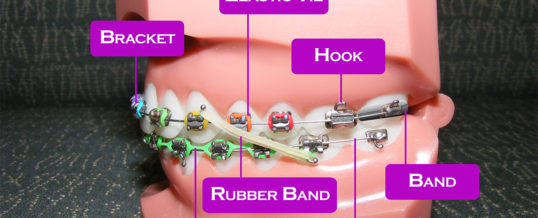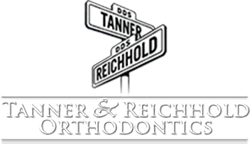
You have made the wise decision to start your child or yourself in orthodontic treatment. Now that you are dealing with braces, you might find yourself faced with terms that you have never come across. Below is a list of several common terms used in orthodontics today:
1. Brackets
Brackets are the metal or ceramic pieces that are bonded to each tooth and hold archwires in place. They are the foundations of braces.
2. Self-ligating brackets
There are brackets that have a locking door which secures the archwire to the brace. They are more hygienic and more comfortable than a traditional bracket. They also are more efficient than a traditional bracket because there is less friction (no rubber elastic ties are necessary) and thus teeth will move faster.
3. Bands
Bands are thin stainless steel metal rings that are cemented typically to the back teeth (the molars) where biting forces are stronger. They are more durable than brackets and do not come loose as readily.
4. Archwires
The archwires are the metal wires that go through all of the bands and brackets of braces and guide the teeth into their new positions. In most cases, you will have an upper archwire and a lower archwire. Some of your orthodontist appointments might be for a new archwire, which means you will be getting a tighter wire to help continue the movement of the teeth.
5. Elastics
Elastics, or rubber bands, are attached to hooks on the teeth and can move teeth in ways that brackets and wires alone cannot do. Elastics are most commonly used to realign the jaws in patients with bite problems such as an overbite, an underbite or a crossbite.
6. Elastic ties or rubber bands
Elastic ties are the little rubber loops or O-rings that secure the archwires to the brackets. One of the fun parts of braces for children is getting to pick from a whole array of colored elastic ties.
7. C-Chain, Power Chain or Energy Chain
A c-chain in similar to elastic ties, except the elastic ties are linked together to form a continuous chain. This type of ligature is extremely effective in closing spaces between teeth and keeping those spaces closed. Power chains or energy chains are simply stronger versions of c-chains.
8. Steel ligature ties
These are similar to elastic ties, but they are made of stainless steel and they are used to secure the archwire more snugly to the bracket. There is a twisted end to these ligatures that can sometimes bend outward and cause irritation, so use a pencil eraser to simply bend it back inward if this occurs.
9. Crimpable or ball hooks
These are small rigid metal hooks that are used to attach rubber bands from the top to the bottom braces.
10. Kobiyashi or k-hooks
These are stainless steel ligatures with hook for elastics similar to crimpable or ball hooks, but they can be easily clipped to remove them when they are no longer needed.
11. Coil spring or push coil
A stainless steel or a nickel titanium spring used to open space between teeth. They work opposite of c-chains.
12. Headgear or neckgear
A common orthodontic appliance that applies extraoral traction for growth modification, tooth movement and anchorage. Headgears and neckgears typically are composed of a stainless steel wire (a facebow) that inserts into metal tubes attached to metal bands on the upper first molars within the mouth. The facebow extends out of the mouth where a thick elastic strap attaches to the facebow and applies a light force backward to help correct an overbite for example.
13. Separators or spacers
Separators, or spacers, are just that. They are very small rings that are placed between teeth to create enough space for metal bands. They typically stay in place for about one week or long enough to create adequate space between back teeth.
14. Bite Plate
A bite plate is an acrylic appliance most commonly used to open one’s bite. It is similar to a retainer, but its main purpose is to prevent the upper teeth from occluding on the lower teeth or biting off the lower braces.
15. Palatal Expander
A palatal expander is an appliance that is often used in the earliest stage of orthodontic treatment, or Phase I. Its name describes its purpose: it expands or widens the upper jaw so that the upper teeth and the lower teeth can fit together better. If the upper jaw is too narrow, the palatal expander will widen the jaw to eliminate a crossbite of the back teeth. It is usually activated over time by turning a key in the center of the expander.
16. Debanding
This is the removal of the braces following the completion of treatment.
17. Gingiva
This is the term describing the gum tissue that surrounds the teeth. It consists of a fibrous tissue that is continuous with the periodontal ligament and mucosal covering.
18. Maxillary
Pertaining to the upper jaw. May be used to describe teeth, dental restorations, orthodontic appliances or facial structures.
19. Mandibular
Pertaining to the lower jaw. May be used to describe teeth, dental restoration, orthodontic appliances or facial structures.
20. Retainer
Any orthodontic appliance, fixed or removable, used to maintain the position of the teeth following orthodontic treatment. Retainers can be made of acrylic and wires (Hawley), clear plastic (Essix or truax) or sometimes wires that are bonded to the backs of teeth permanently.
21. Retention
The passive treatment period following active orthodontic correction during which retainers are typically used.
Whether you are new to braces for kids or adults, or already in full treatment, it never hurts to have a better understanding of some of the terms you might hear at your visits to the orthodontist.
By Dr. Gary Reichhold
FEB

About the Author:
Dr. Gary Reichhold and his partner Dr. Stephen Tanner have been proudly serving families in Concord, Walnut Creek, Clayton, Pleasant Hill and the surrounding communities for over 20 years. Their office is conveniently located in central Contra Costa County and their experienced team is committed to providing you and your family with exceptional orthodontic care.